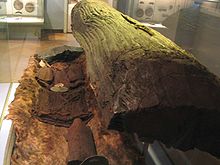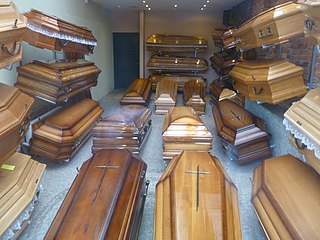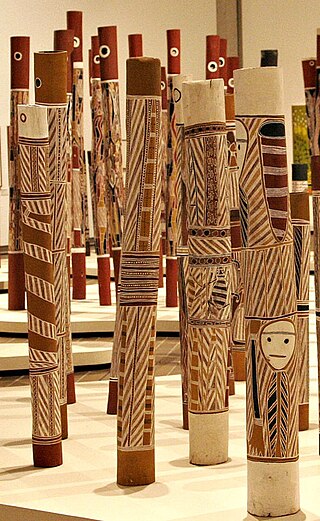


A treetrunk coffin is a coffin hollowed out of a single massive log. Such coffins have been used for burials since prehistoric times over a wide geographic range, including in Europe, Africa, Asia and Australia.



A treetrunk coffin is a coffin hollowed out of a single massive log. Such coffins have been used for burials since prehistoric times over a wide geographic range, including in Europe, Africa, Asia and Australia.
Treetrunk coffins were a feature of some prehistoric elite burials over a wide geographical range, especially in Northern Europe and as far east as the Balts, where cremation was abandoned about the 1st century CE, as well as in central Lithuania, where elites were also buried in treetrunk coffins. [1] The practice survived Christianisation into the Middle Ages. [2]
The coffin in which the body of King Arthur, said to have been discovered at Glastonbury Abbey in 1191, was described by the contemporary chronicler Giraldus Cambrensis as being of a massive oak treetrunk. For Bronze Age Britain, examples have been recorded at Wydon Eals, near Haltwhistle, and at Cartington, (formerly County Durham, now Northumberland), [2] in Scotland, Yorkshire, East Anglia (Liss, northeast Hampshire, for instance). In Yorkshire, "Gristhorpe Man", [3] a well-preserved human of the second millennium BCE, who was found on 10 July 1834 under an ancient burial mound buried in a hollow oak tree trunk, is conserved at the Rotunda Museum, Scarborough. He was wrapped in an animal skin with a whalebone and bronze dagger and food for his journey.
At the abbey of Munsterbilzen, Belgium, ten graves with massive treetrunk coffins were discovered in 2006.[ citation needed ]
The Egtved Girl was buried in a treetrunk coffin near Egtved, Denmark in around 1370 BCE.
The phenomenon was not restricted to regions where massive timber was abundant. In Egypt, the conservation of a 1st-century cypresswood coffin hollowed from a single log, from a burial at Touna El Gebel, has been described. [4]

The hollow log coffin (also known as memorial poles, lorrkkon, ḻarrakitj, or ḏupun) has been used in burials of Yolngu and Bininj peoples of Arnhem Land in the Northern Territory of Australia for millennia. They vary in size: those made for a burial ceremony are large, while smaller logs may hold the bones of a person, to be kept by their family for some time. They can also represent the deceased person, with designs mirroring those painted on the body during the burial rites. Sometimes there is a small painted or carved hole near the top, provided to allow the deceased's soul to look out on the land. [5] Traditionally, the log is that of the stringybark Eucalyptus tetrodonta which has been naturally hollowed out by termites. [6] [7] The poles are painted with elaborate and intricate designs, which relate to the deceased's clan, and are believed to help guide the soul to its home, where spirits and ancestors would then recognise it. [8]
In recent decades, the larrakitj have been created as artworks, [8] and have been exhibited in many major Australian galleries. The National Gallery of Australia in Canberra holds an installation called the Aboriginal Memorial . originally created in 1988. [9]
Because hollowed trunks suggest dugout boats, such burials are sometimes described as boat burials. In Yanjinggou Developing Zone of Chengdu such a "boat burial" in a hollowed-out treetrunk found in 2006 was dated to the Warring States Era (475–221 BCE); it contained copper objects, bronze weapons, pottery and lacquer wares, seeds and peach pits. Its burial was the most recent of eight burials in coffins hollowed out of single treetrunks one and a half metres in diameter, five meters in length, with tapered ends bow and stern.[ citation needed ]

Burial, also known as interment or inhumation, is a method of final disposition whereby a dead body is placed into the ground, sometimes with objects. This is usually accomplished by excavating a pit or trench, placing the deceased and objects in it, and covering it over. A funeral is a ceremony that accompanies the final disposition. Evidence suggests that some archaic and early modern humans buried their dead. Burial is often seen as indicating respect for the dead. It has been used to prevent the odor of decay, to give family members closure and prevent them from witnessing the decomposition of their loved ones, and in many cultures it has been seen as a necessary step for the deceased to enter the afterlife or to give back to the cycle of life.

A coffin is a funerary box used for viewing or keeping a corpse, either for burial or cremation.

The ancient Egyptians had an elaborate set of funerary practices that they believed were necessary to ensure their immortality after death. These rituals included mummifying the body, casting magic spells, and burials with specific grave goods thought to be needed in the afterlife.
Ramingining is an Aboriginal Australian community of mainly Yolngu people in the Northern Territory, Australia, 560 kilometres (350 mi) east of Darwin. It is on the edge of the Arafura Swamp in Arnhem Land. Wulkabimirri is a tiny outstation (homeland) nearby, and Murwangi, further south, is part of the Ramingining Homelands. Marwuyu Gulparil, also known as Gulparil Marwuyu or just Marwuyu, is another remote community to the south of Ramingining.

Bronze Age Britain is an era of British history that spanned from c. 2500–2000 BC until c. 800 BC. Lasting for approximately 1,700 years, it was preceded by the era of Neolithic Britain and was in turn followed by the period of Iron Age Britain. Being categorised as the Bronze Age, it was marked by the use of copper and then bronze by the prehistoric Britons, who used such metals to fashion tools. Great Britain in the Bronze Age also saw the widespread adoption of agriculture.
Châu Can is an archaeological site in the Red River Delta in northern Vietnam. It was located in Hà Sơn Bình province when it was excavated in 1974, but in 1975 was reorganized into Hà Tây province. Excavations there yielded a number of coffins containing relics of the Bronze Age Đông Sơn culture.

Funerary art is any work of art forming, or placed in, a repository for the remains of the dead. The term encompasses a wide variety of forms, including cenotaphs, tomb-like monuments which do not contain human remains, and communal memorials to the dead, such as war memorials, which may or may not contain remains, and a range of prehistoric megalithic constructs. Funerary art may serve many cultural functions. It can play a role in burial rites, serve as an article for use by the dead in the afterlife, and celebrate the life and accomplishments of the dead, whether as part of kinship-centred practices of ancestor veneration or as a publicly directed dynastic display. It can also function as a reminder of the mortality of humankind, as an expression of cultural values and roles, and help to propitiate the spirits of the dead, maintaining their benevolence and preventing their unwelcome intrusion into the lives of the living.

The remains of Gristhorpe Man were found buried in a coffin in Gristhorpe, North Yorkshire, England. They have been identified as a Bronze Age warrior chieftain. A few other examples of burial in a scooped-out oak tree have been found in Scotland and East Anglia, but it was an unusual method of inhumation in the UK and the remains found near Scarborough, are the best preserved. The remains were discovered in 1834 in a burial mound near Gristhorpe and excavated under the auspices of the Scarborough Philosophical Society. The Bronze Age remains were originally donated to the Rotunda Museum in Scarborough and a report of the excavation was published in the same year by the precocious 17-year-old William Crawford Williamson, the son of the Museum curator. They were taken to Bradford in 2005 for a new evaluation directed by Drs. Nigel Melton and Janet Montgomery, while the museum was being refurbished.

The Aboriginal Memorial is a work of contemporary Indigenous Australian art from the late 1980s, and comprises 200 decorated hollow log coffins. It was conceived by Djon (John) Mundine in 1987–88 and realised by 43 artists from Ramingining and neighbouring communities of Central Arnhem Land, in the Northern Territory. Artists who participated in its creation included David Malangi and George Milpurrurru.
Hollow log may refer to:

Marrnyula Mununggurr (1964) is an Aboriginal Australian painter of the Djapu clan of the Yolngu people, known for her use of natural ochres on bark and hollow logs, wood carvings, linoleum and screen print productions.

Gabriel Maralngurra is a artist from the Ngalangbali clan Kunwinjku artist in West Arnhem Land. As an aboriginal artist, he is well-known and respected within his community for the wide range of responsibilities he takes on. His artwork is displayed in various collections including the Australia Museum, Museum Victoria, and the Kluge-Ruhe Aboriginal Art Collection of the University of Virginia.
Jimmy Wululu was an Aboriginal Australian artist of the Gupapuyngu language group. He was a major contributor to the Aboriginal Memorial and he was one of the major painters of the 1980s from his language group. He is known for his bark paintings and his memorial poles. His works have been featured in numerous significant exhibits all over the world.
Dorothy Djukulul is a traditional Australian Aboriginal artist who lives in Ramingining in Central Arnhem Land. She speaks Ganalbingu and is a part of the Gurrumba Gurrumba clan, who identify as being a part of the Yirrija moiety.
Malaluba Gumana is an Australian Aboriginal artist from northeast Arnhem Land, who has gained prominence through her work in painting and the production of larrakitj, the memorial poles traditionally used by Yolngu people in a mortuary ceremony.

Wukun Wanambi was an Australian Yolngu painter, filmmaker and curator of the Marrakulu clan of northeastern Arnhem Land, Northern Territory.
Dhambit Mununggurr is a Yolngu artist of the Gupa-Djapu clan known for her unique ultramarine blue bark paintings inspired by natural landscapes and Yolngu stories and legends. In 2005, Mungunggurr was hit by a truck, leaving her wheelchair bound and stopping her from painting for five years. The incident effected her painting by limiting her use of her right hand.
Nancy Gaymala Yunupingu was a senior Yolngu artist and matriarch, who lived in Arnhem Land in the Northern Territory, Australia. She worked at the Buku-Larrnggay Mulka Centre in Yirrkala, where her work is still held, and is known for her graphic art style, bark paintings and printmaking.

A memorial pole, also known as hollow log coffin, burial pole, lorrkkon, ḻarrakitj, or ḏupun, is a hollow tree trunk decorated with elaborate designs, made by the Yolngu and Bininj peoples of Arnhem Land in the Northern Territory of Australia. Originally used to hold the bones of deceased people or for burial ceremonies, they are now made as works of art. The permanent exhibit at the National Gallery of Australia, Aboriginal Memorial, consists of 200 hollow log coffins, created by 43 artists.
Naminapu "Nami" Maymuru-White is a senior Yolŋu artist of North East Arnhem Land, in the Northern Territory of Australia. She is known for representing her the songlines of her clan, the Maŋgalili group, especially the stars and their reflections in the local rivers. She has been invited to exhibit at the Venice Biennale in July 2024.